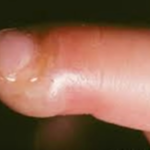Encephalomalacia is a brain disorder characterized by local or widespread softening of tissues in brain. Such softening usually occurs due to inflammation or hemorrhage and the softened area of brain does not function at all. Different areas of the brain may be adversely affected and tissue damage may occur in frontal, temporal, occipital, and parietal lobes. The condition is also known as cerebral softening.
Encephalomalacia can occur in people of all age groups including babies in womb. Uncommonly, brain deterioration or degeneration may cause extensive softening of matter in brain.
Symptoms of encephalomalacia
The symptoms are dependent on the affected section of brain that ceases to function. They can be mild or severe. Some common signs and symptoms are mentioned below:
- Drowsiness and/or increased desire to sleep or episodic somnolence
- Pressure in head
- Extreme headache
- Diminished coordination marked by unsteady or ungainly movements
- Impaired sight
- Temporary or permanent loss of vision
- Encephalomalacia of frontal lobe may result in mood swings and/or memory loss
- Intense head spinning sensation (vertigo)
- Fatal coma
- Sometimes, there may be variance in brain size leading to changes in brain pliability
Types of encephalomalacia
Classification of encephalomalacia is also dependent on the area of brain that is affected. The two types are mentioned below:
- Polioencephalomalacia: In this type, the brain’s grey matter is adversely affected. Patients may suffer from loss of or extensive decrease in sensory acuity, emotions, speech, memory, and muscle regulation/control
- Leukoencephalomalacia: In this type, the brain’s white matter is adversely affected. The part of brain that gets affected is responsible for transmission of nerve signals in cerebrum and between the lower brain centers and the cerebrum.
The progress of encephalomalacia can also be classified according to the phase, colors, and level of harm to brain. They are of 3 types, as listed below:
- Red cerebral softening: Death of brain tissue due to reduced or no supply of oxygen may cause the occurrence of this stage of encephalomalacia. Blockage in veins present in brain may hamper oxygen supply. The area of hemorrhagic infarct experiences influx of RBCs which causes the tissues to turn reddish. Occurrence of blood clots, gas bubbles, globules, and alien substances in bloodstream may trigger embolism.
- Yellow cerebral softening: This may occur due to buildup of atherosclerotic plaque in the brain’s arteries. Also, there is concurrent accumulation of yellow lymph across the choroid plexus of the brain; this imparts the yellowish hue to affected brain tissue.
- White cerebral softening: This type affects that section of brain with reduced or nil supply of blood. Poor blood flow eventually leads to neuronal tissue death.
Causes
Encephalomalacia can affect all age groups, but its manifestation differs between people of different ages. Infants suffer from more extreme complications than adults due to the fact that adult brains are capable of recovering damaged tissues of brain as well as compensating for loss/reduction of abilities via usage of functioning brain areas for such activities.
A few common causes of cerebral softening are mentioned below:
- Mini stroke
- Varied diseases may trigger encephalomalacia-like decline in brain function
- Severe head injury marked by bleeding or brain hemorrhage
- Sections of brain with abnormal accumulation of blood may suffer from encephalomalacia
- In rare instances, brain degeneration may be a cause
- Stroke which causes death of tissues in certain parts of brain may cause neurons to be substituted by astrocytes created scar tissue. When such scar tissue repeatedly contract, then cerebral softening may occur.
- Poor blood flow to brain is another cause of encephalomalacia. Blood flow problems may arise due to severe inflammation or swelling of brain, a stroke, brain tumor surgery, brain tumor which causes extensive damage or destruction of nearby brain tissues, and/or obstructions in blood vessels supplying to brain.
- Malfunction of brain caused by heavy blow to head, or other severe brain trauma, or cranio-cerebral injury
- Infection of brain by toxic chemicals or pathogens. Infection may be direct or migrate from other areas to brain via bloodstream
- Increased levels of protein and low glucose in cerebrospinal fluid may cause a future case of cerebral softening triggered by some kind of viral infection, etc.
- White matter may degenerate in newborns due to asphyxia or infection, thereby causing encephalomalacia
- It was previously believed that birth trauma may be a possible cause. It is not so now due to lack of empirical proof.
Treatment of encephalomalacia
- Dead, damaged, or destroyed tissues of brain cannot be rebuilt. Hence, encephalomalacia has no cure.
- Early detection of encephalomalacia and its cause can help manage symptoms and prevent severe complications.
- Doctors may surgically remove severely damaged tissues in brain. This may or may not improve different senses or brain functions
- Scientists are currently studying whether stem cell therapy can help treat cerebral softening
